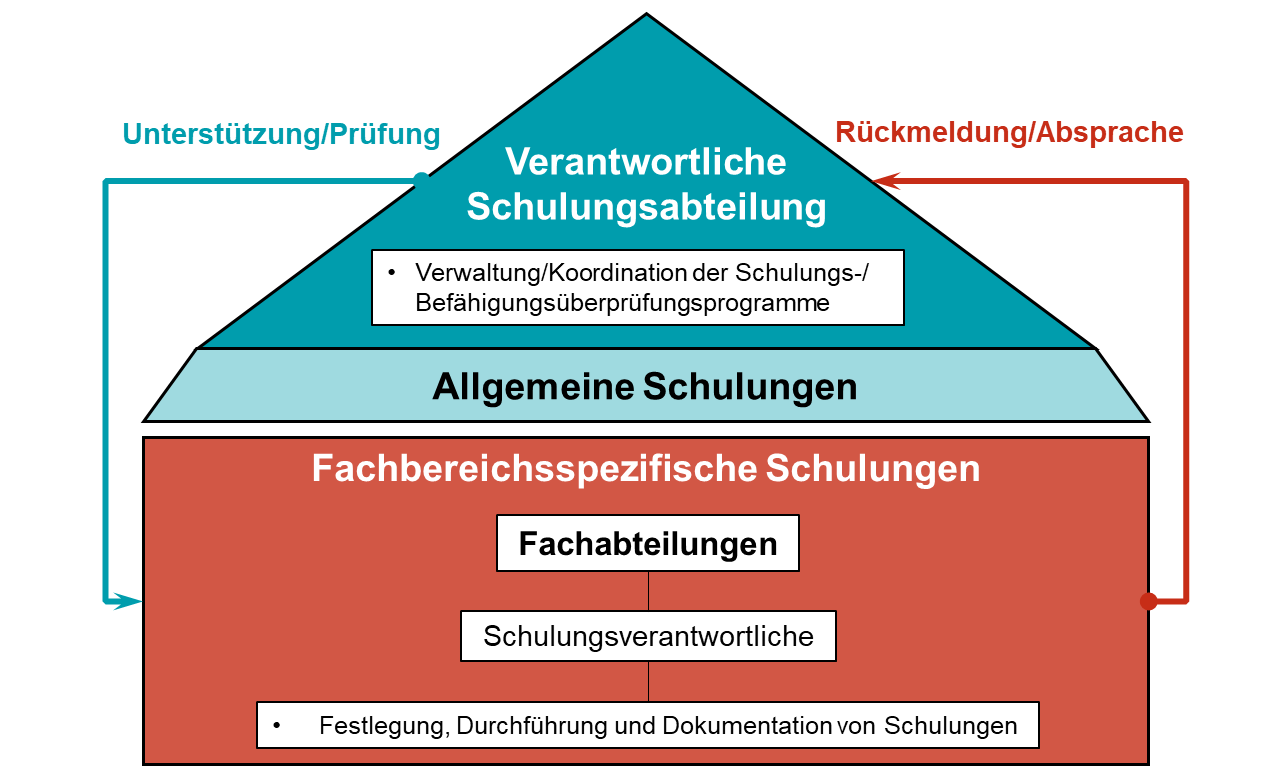Requirements for training and proficiency checks
The European Aviation Safety Agency (EASA) has developed specific guidelines and specifications, which, among other things, define requirements for the organisational and operational structures of aerodromes in accordance with the guideline AMC and GM to Authority, Organisation and Operations Requirements for Aerodromes (Part ADR.AR/OR/OPS).
According to this guideline, aerodrome operators are required to establish and operate a training and proficiency check programme to ensure that airport personnel
- involved in operation, maintenance and management or
- operating unescorted on the movement areas
are accordingly qualified.
The objective of the training courses is to ensure that personnel are familiar with the applicable regulations/procedures of aerodrome operations and can always safely perform the assigned activities and responsibilities. A differentiation can be made in:
- formal training requirements according to ADR.OR.D.017 and
- training contents according to Part-ADR.OPS (flight operational requirements).
Formal training requirements:
This mainly covers the following aspects:
- the provision of initial, recurrent and refresher training,
- Appointment of instructors and assessors (internal/external) for implementation and subsequent evaluation,
- Carrying out proficiency checks using appropriate procedures (e.g. practical and theoretical tests, WBT etc.),
- Uniform documentation of personnel data and all qualification measures,
- Guarantee of prescribed time intervals,
- Development of validation procedures for training effectiveness and dealing with non-compliance with training standards,
- Recording of the qualification programme in the aerodrome manual etc.
Training contents:
The training contents include the following focal points, considering the local conditions and boundary conditions:
- Aerodrome data (ADR.OPS.A): including data quality and data exchange/coordination with AIS providers
- Aerodrome operational services, equipment and installations (ADR.OPS.B): including aerodrome emergency plan, RFFS, inspection of movement areas, vehicle operations, wildlife hazard management, winter, night, low visibility and bad weather operations, construction works, etc.
- Aerodrome maintenance (ADR.OPS.C): including surface and drainage of movement areas, visual aids and electrical systems
Conception of qualification programs
The starting point for the development of the training concept is the analysis of status quo and subsequently a gap analysis, which is mainly used to check the conformity of the training and proficiency check programme implemented so far at the aerodrome.
Analysis of status quo:
The aim of the status quo’s analysis is to record the training and proficiency checks already in place at the aerodrome in cooperation with the responsible aerodrome departments. Generally, this may be divided into
- general, superordinated training courses for a group of people working across departments and
- specialist training for a limited group of people.
Gap analysis:
For the examination of completeness and identification of possible deviations from the relevant EASA guidelines (compliance analysis), the identified training courses and proficiency checks are checked regarding formalities (e.g. time intervals and documentation) and contents. Mitigation measures in case of identified deviations can be e.g. the revision of the content of existing training courses and/or implementation of completely new training courses.
Implementation of training programme:
As a result of the status quo and gap analysis, the training program is defined with the customer. Components of this are:
- Training content and procedures for coordinating training delivery and documentation,
- Dynamic documentation procedure (integration into the existing IT infrastructure),
- Methodology related to the need/implementation of proficiency checks,
- Procedures for checking effectiveness (e.g. feedback forms),
- Training requirements for external companies,
- Procedure for the proof of qualification, especially external instructors/assessors etc.
Development and implementation of training courses
A further component of our service portfolio is the development of training content and the subsequent implementation of qualification measures.
Development of training courses:
The development of training courses and their contents is characterized by the following features, among others:
- Training contents focus primarily on the above-mentioned flight operational requirements according to EASA Part-ADR.OPS,
- Consideration of further focal points according to EASA, ICAO or national guidelines, which go beyond the above-mentioned guideline requirements (e.g. infrastructure design),
- Contents include, in addition to superordinate guideline requirements, especially the boundary conditions prevailing at the respective aerodrome as well as implemented procedures/processes,
- Adaptation of the contents to specific groups of people at the aerodrome and
- Close coordination with the customer to ensure effective and efficient qualification of the participants for the respective training topic.
Implementation of training courses:
In this respect we offer our customers the following focal points:
- Implementation of classroom training for smaller user groups (special topics) both in-house at the customer and externally,
- Setup of Web Based Training (WBT) for larger user groups (general topics)
- Preparation of training materials, such as PowerPoint presentations, video tutorials, practical training (case studies), exercises and training manuals
- Creation of proficiency checks as multiple choice (written tests or integrated into WBT),
- Guarantee of appropriate professional competence: trainer pool consisting of graduate engineers from the aviation sector and
- Development of company specific training packages.
The training topics include, for example, the design of movement areas according to EASA CS-ADR-DSN, obstacle investigation at airports and safety and risk assessments at airports. The respective contents can be adapted to the needs of the client.
The above information can also be found in our flyer "Training and Proficiency Programmes for Aerodromes according to EASA" in the download area.


